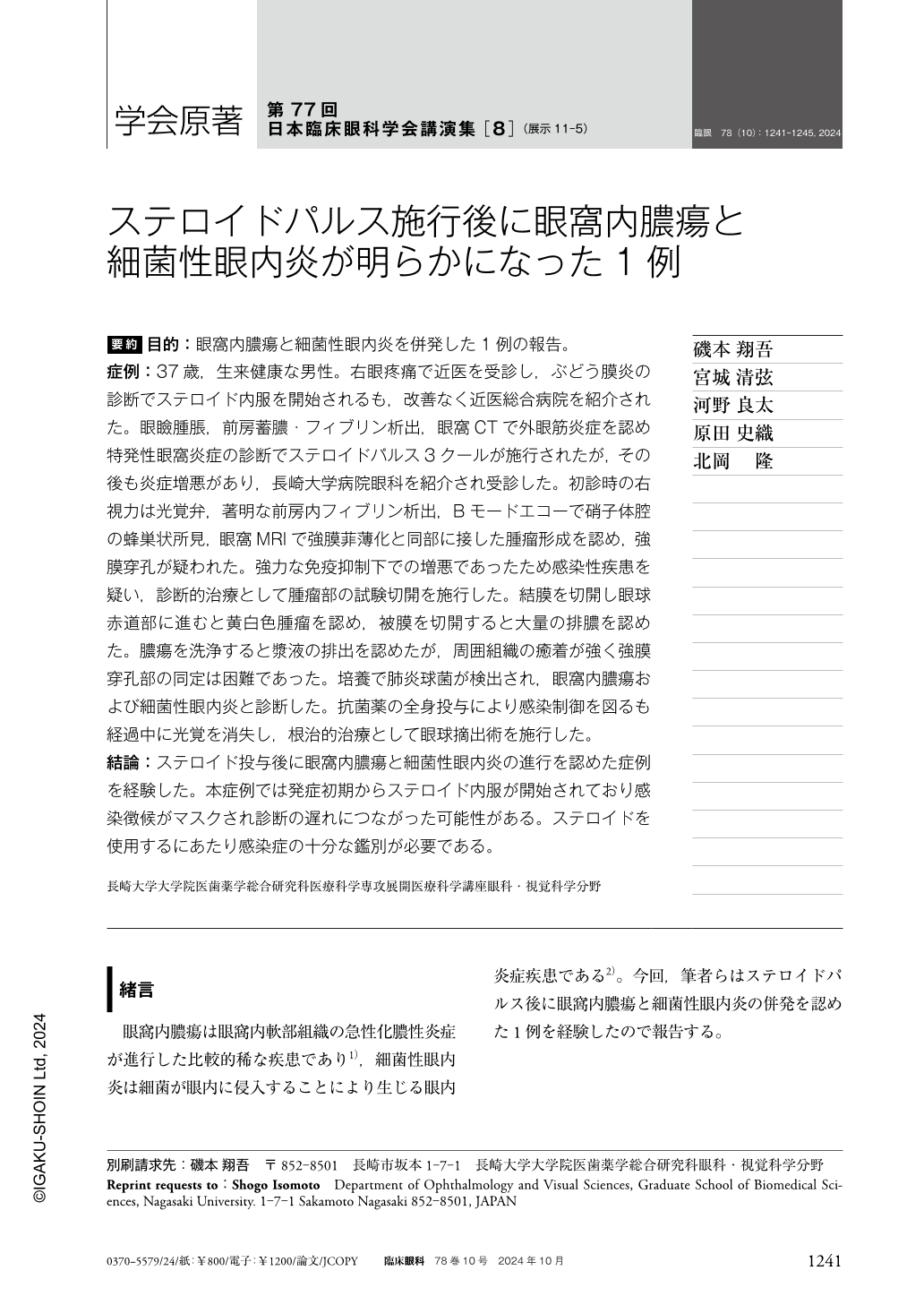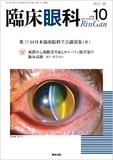Japanese
English
- 有料閲覧
- Abstract 文献概要
- 1ページ目 Look Inside
- 参考文献 Reference
要約 目的:眼窩内膿瘍と細菌性眼内炎を併発した1例の報告。
症例:37歳,生来健康な男性。右眼疼痛で近医を受診し,ぶどう膜炎の診断でステロイド内服を開始されるも,改善なく近医総合病院を紹介された。眼瞼腫脹,前房蓄膿・フィブリン析出,眼窩CTで外眼筋炎症を認め特発性眼窩炎症の診断でステロイドパルス3クールが施行されたが,その後も炎症増悪があり,長崎大学病院眼科を紹介され受診した。初診時の右視力は光覚弁,著明な前房内フィブリン析出,Bモードエコーで硝子体腔の蜂巣状所見,眼窩MRIで強膜菲薄化と同部に接した腫瘤形成を認め,強膜穿孔が疑われた。強力な免疫抑制下での増悪であったため感染性疾患を疑い,診断的治療として腫瘤部の試験切開を施行した。結膜を切開し眼球赤道部に進むと黄白色腫瘤を認め,被膜を切開すると大量の排膿を認めた。膿瘍を洗浄すると漿液の排出を認めたが,周囲組織の癒着が強く強膜穿孔部の同定は困難であった。培養で肺炎球菌が検出され,眼窩内膿瘍および細菌性眼内炎と診断した。抗菌薬の全身投与により感染制御を図るも経過中に光覚を消失し,根治的治療として眼球摘出術を施行した。
結論:ステロイド投与後に眼窩内膿瘍と細菌性眼内炎の進行を認めた症例を経験した。本症例では発症初期からステロイド内服が開始されており感染徴候がマスクされ診断の遅れにつながった可能性がある。ステロイドを使用するにあたり感染症の十分な鑑別が必要である。
Abstract Purpose:A case report of a patient with intraorbital abscess and bacterial endophthalmitis.
Case:A 37-year-old naturally healthy male visited a nearby hospital due to pain in his right eye. He was diagnosed with uveitis and was treated with oral steroids, but the patient did not improve and was referred to a general hospital. Symptoms included eyelid swelling, hypopyon and fibrin precipitation, and orbital CT showed inflammation of the external ocular muscle, which led to a diagnosis of idiopathic orbital inflammation. He was treated with 3 courses of steroid pulse therapy, but the inflammation worsened thereafter, and he was referred to our department. At the time of initial examination, his visual acuity in the right eye was light perception and scleral perforation was suspected due to marked fibrin precipitation, honeycomb-like echo in the vitreous cavity on B-mode echography, and scleral thinning and mass formation adjacent to the same area on orbital MRI. As the exacerbation occurred under strong immunosuppression, we suspected infectious disease and performed an experimental incision of the mass as a diagnostic treatment. A conjunctival incision was made and progressed to the equatorial part of the eye, where a yellowish-white mass was observed, and when the capsulotomy was made, a large amount of drainage of pus was observed. When the anterior chamber was washed, serous fluid was found to be discharged under the conjunctiva, but the surrounding tissue was strongly adherent and it was difficult to identify the scleral perforation. Streptococcus pneumoniae was detected in culture, and a diagnosis of intraorbital abscess and bacterial endophthalmitis was made. Systemic antibiotic therapy was administered to control the infection, but the patient's light perception disappeared during the course of the treatment, and an ophthalmectomy was performed as a curative treatment.
Conclusion:We encountered a case of intraorbital abscess and progression of bacterial endophthalmitis after steroid administration. In this case, the patient was started on steroids early in the course of the disease, which may have masked the signs of infection and led to a delay in diagnosis. When steroids are used, infection must be adequately differentiated.

Copyright © 2024, Igaku-Shoin Ltd. All rights reserved.


